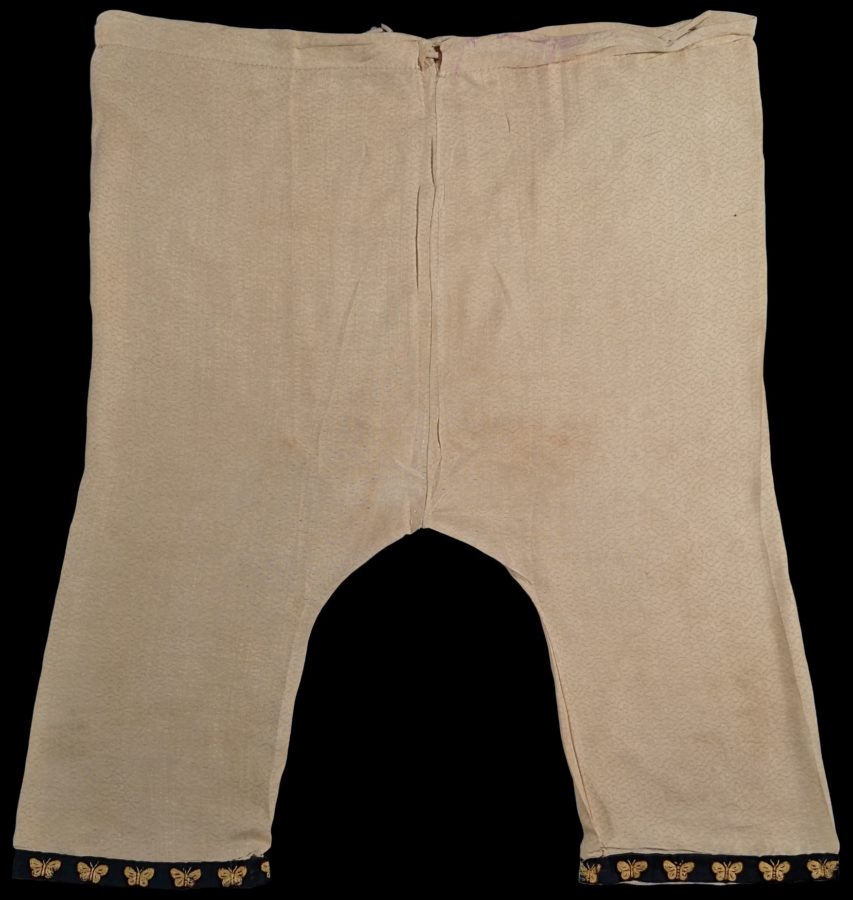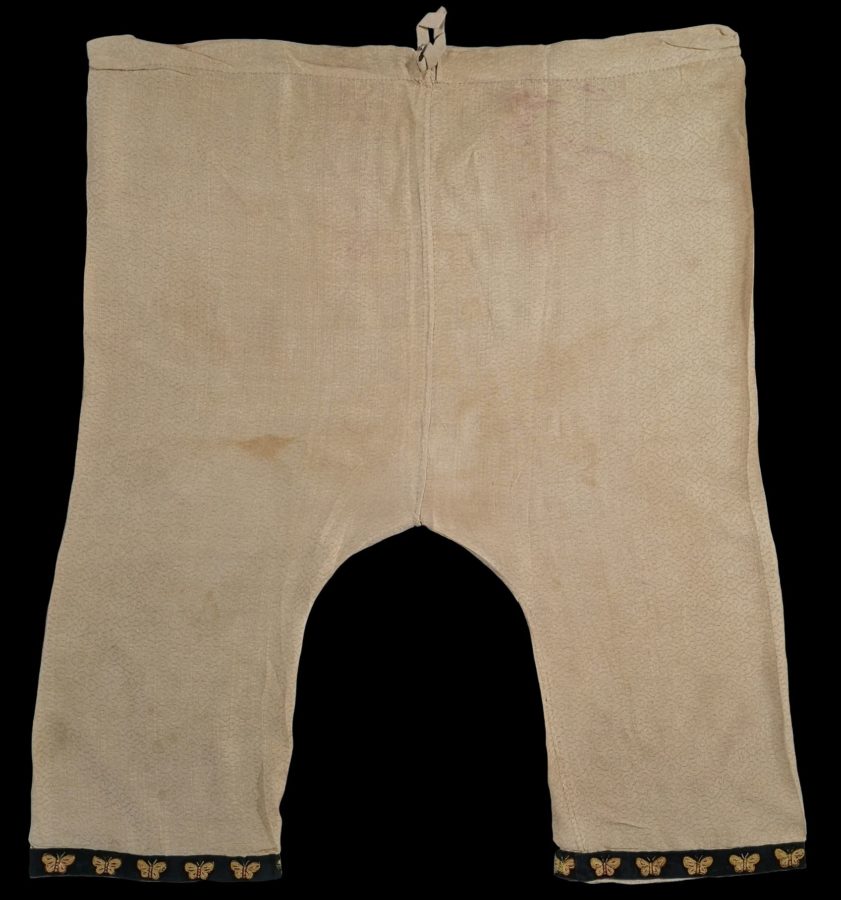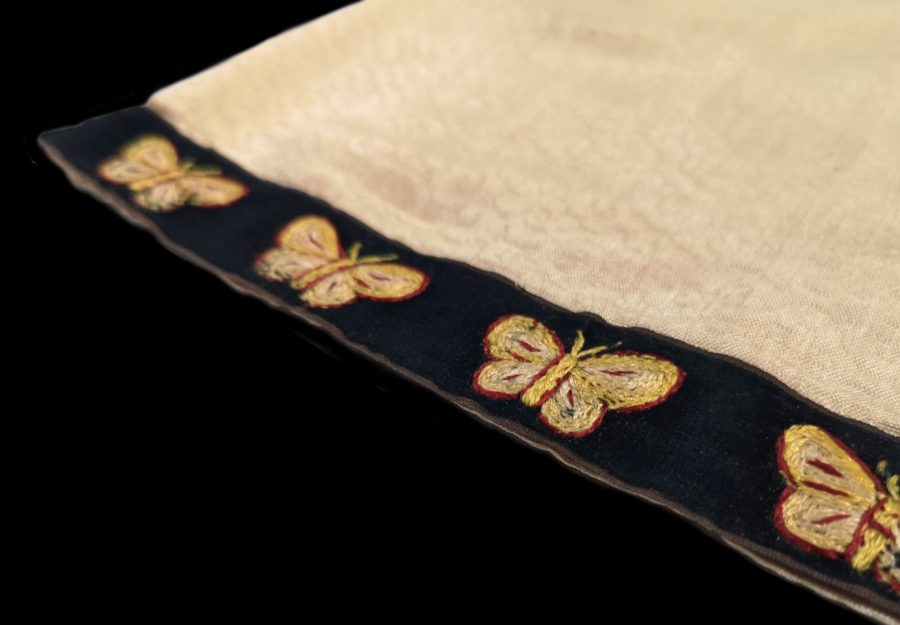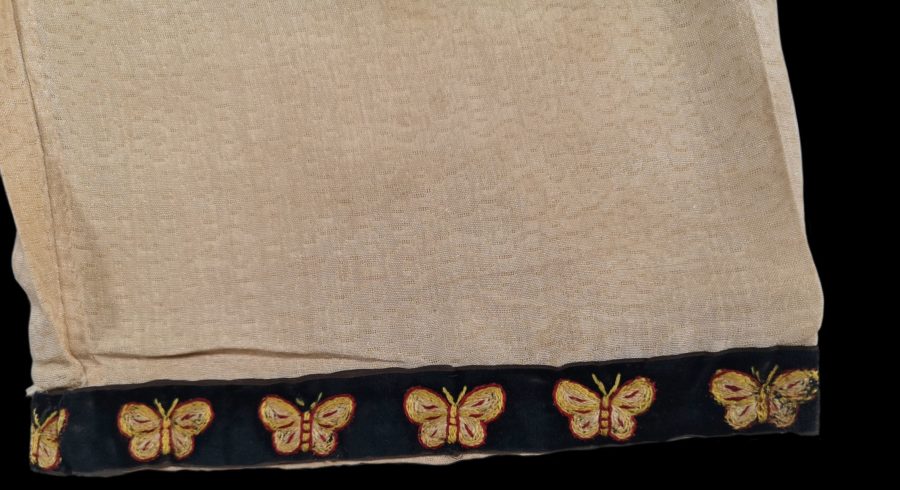Enquiry about object: 5378
Parsi (Parsee) Pantaloons (Ijar)
Parsi (Parsee) community of Bombay, India. early 20th century
width: 55cm, length: 70cm
Provenance
from the family collection of a Parsi family based in northern England but originally from Bombay, India.
This pair of loose, pyjama-style pantaloons known as an ijar is of jacquard-weave silk with embroidered cuff borders (kor) that are decorated with butterflies. It has a string for fastening.
Such a garment was worn by Parsi (Parsee) women under their sari.
Embroidered garments imported from Canton became popular with the Parsis of Gujarat in the nineteenth century. Many Parsi merchants had agencies and trading houses in Hong Kong and Shanghai as they did elsewhere in Asia, so it was a relatively simple matter for the Parsi community to access Chinese embroidered items for the market back home. The popularity of these Chinese-made textiles became such that the Parsi community began to embroider their own silk garments in the Chinese style. The town of Surat in western India, which had a significant Parsi population, was also home to a long- established embroidery industry, and so Surat became the centre of Parsi embroidery in the ‘Chinese’ style (Shah & Vatsal, 2010, p. 114).
Similar examples are illustrated in Shah & Vatsal (2010, p. 94) and Godrej & Punthakey Mistree (2002, p. 578).
The ijar here is in fine condition. It was sourced in the UK from a Parsi family with origins in Bombay.
The Parsis, who follow the ancient religion of Zoroastrianism, first came to India from Persia in the 8th or tenth century, fleeing religious persecution. Today, probably there are about 125,000 Parsis or Zoroastrians worldwide. About 70,000 live in Mumbai/Bombay, a city of 14 million people. Another 1,700 live in Karachi in Pakistan. The Parsis of India and Pakistan are a distinct but exceptionally successful commercial minority. By the nineteenth century, Bombay’s Parsi families dominated the city’s commercial sector, particularly in spinning and dyeing and banking. Wealth from these activities was put into property so that by 1855, it was estimated that Parsi families owned about half of the island of Bombay. Today, India’s most prominent Parsi family is the Tata Family, founders and owners of India’s most prominent conglomerate the Tata Group. Despite their wealth, India’s Parsi community is hugely respected and admired in India because of the community’s humility and charitable works which extend way beyond serving members of their own community.
Well-off though they are as a community, the Parsis are dying out. It has been estimated that a thousand Parsis die each year in Mumbai, but only 300- 400 are born. Today, one in five Mumbai Parsis is aged 65 or more. In 1901 the figure was one in fifty. Low birth rates are the main factor. Probably no Parsis remain in Burma today.
The sari here is in excellent condition. It was sourced in the UK from a Parsi family with origins in Bombay.
The Parsis, who follow the ancient religion of Zoroastrianism, first came to India from Persia in the 8th or tenth century, fleeing religious persecution. Today, probably there are about 125,000 Parsis or Zoroastrians worldwide. About 70,000 live in Mumbai/Bombay, a city of 14 million people. Another 1,700 live in Karachi in Pakistan. The Parsis of India and Pakistan are a distinct but exceptionally successful commercial minority. By the nineteenth century, Bombay’s Parsi families dominated the city’s commercial sector, particularly in spinning and dyeing and banking. Wealth from these activities was put into property so that by 1855, it was estimated that Parsi families owned about half of the island of Bombay. Today, India’s most prominent Parsi family is the Tata Family, founders and owners of India’s most prominent conglomerate the Tata Group. Despite their wealth, India’s Parsi community is hugely respected and admired in India because of the community’s humility and charitable works which extend way beyond serving members of their own community.
Well-off though they are as a community, the Parsis are dying out. It has been estimated that a thousand Parsis die each year in Mumbai, but only 300- 400 are born. Today, one in five Mumbai Parsis is aged 65 or more. In 1901 the figure was one in fifty. Low birth rates are the main factor. Probably no Parsis remain in Burma today.
References
Godrej, P.J. & F. Punthakey Mistree, A Zoroastrian Tapestry: Art, Religion & Culture, Mapin Publishing, 2002.
Shah, S., & T. Vatsal, Peonies & Pagodas: Embroidered Parsi Textiles – The Tapi Collection, Garden Silk Mills, 2010.









